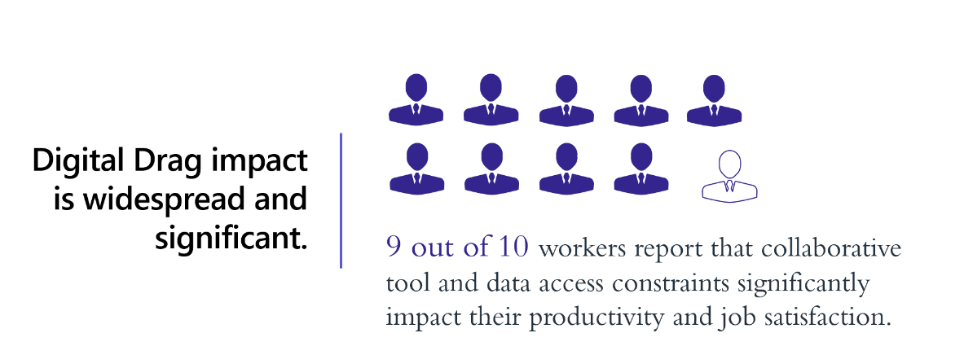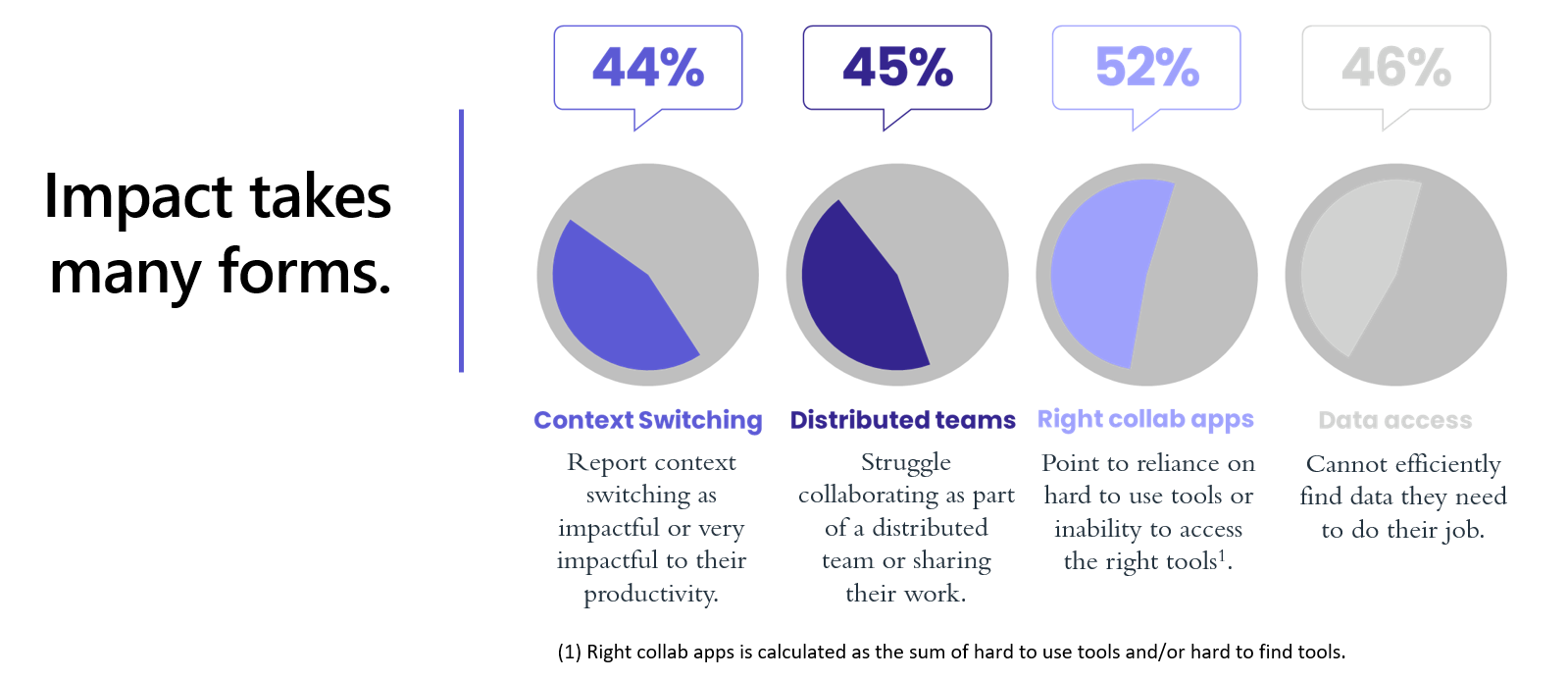Editor’s note: Register for a fireside chat with David Brodeur-Johnson, Principal Analyst, Forrester Research for a deep dive on this topic on November 7, at 8:00 AM PT.
The pandemic upended closely held assumptions about how, where, and when work needed to happen. Sadly, the sweeping changes that followed have not come with operating instructions leaving Enterprises scrambling to rewrite their “rules of the road” on their own and in near real time.
The initial chaos is, thankfully, behind us, and the timing is right to look more closely into what has worked and, most importantly, what is still holding us back from fully tapping into the new world of generative AI and modern work.
To help answer these questions, Microsoft commissioned Forrester Consulting to conduct a survey of over 1,000 IT and business decision-makers across industries and regions. The survey results are in, and they hold some surprising – and timely – insights into unlocking individual and organizational success.
Collaboration By Design In An Age Of Generative AI And The Modern Workplace [1] (The Survey) offers key insights into a broad category of risk – Digital Drag – its symptoms, the toll it can take on individual and organizational success, and its root causes.
The Survey offers actionable insights that can help organizations move into the fast lane of modern work and generative AI.
Want to dig into these results? Register for the upcoming fireside chat with David Brodeur-Johnson, the lead author of Forrester’s Employee Experience Index and the principal analyst behind this report as well.
Digital Drag
Digital Drag can be defined as the sum of the inefficiencies stemming from data access, automation, and collaboration tooling and can be measured in the time syphoned away from core work duties.
The Survey showed that a staggering 9 out of 10 respondents reported that collaborative tool and data access constraints significantly impact their productivity and job satisfaction.

The Survey revealed a digital pandemic with a broad spectrum of consequential symptoms.

Taken together, these symptoms translate into a productivity-crushing Digital Drag.
Survey respondents flagged the following symptoms:
- Context switching: Toggling between tools and platforms disrupts flow and eats up valuable time.
- Distributed team inefficiencies: Without the right tools, collaboration across locations, time zones, and languages is fraught with inefficiencies and errors.
- Tool-related hurdles: Whether the tools are hard to locate or just frustrating to use, the barriers are real and tangible.
- Data access frustration: When users struggle to access, locate, or repurpose data, their work suffers and their job satisfaction plummets.
In their own words: a qualitative sampling
The steep price of Digital Drag
On average, survey respondents indicated that 40% of their workday was syphoned off into tasks other than their “primary work.” Said another way, the average respondent had to push their way through a two-day drag that resulted in a three-day work effort taking five days to complete.
But here is where the results get really interesting: not all organizations face the same headwind. Comparing the top-performing 20% with the bottom 20% revealed that Digital Drag is not a constant or a flat tax on work. In fact, The Survey showed that Digital Drag is highly variable with the poorest performing group of respondents spending a whopping 68% of their time on non-core activities while the top performing group spent only 19%.

Extending the example above, a team of 5 top performers would produce 20 person days of work/week whereas the poorest performing 20% would only produce 8 person days/week.
How can any organization hope to thrive under that kind of resistance?
The root cause of Digital Drag
What distinguishes the high performers from their less efficient counterparts? The Survey data did not point to any single fatal flaw or obstacle that could be correlated with top or bottom performers. What The Survey did show was that organizations with the highest count of obstacles were more likely to have the highest Digital Drag (no matter which obstacles) e.g., the poorest performance. What does that tell us about Digital Drag?

Eliminating Digital Drag (improving organizational aerodynamics)
The good news from these results is that Digital Drag, while potentially devastating, is not predetermined and can be minimized by eliminating friction points. But there is also a flip side to these results. Digital Drag is an aggregate that arises from a collection of individual inefficiencies. Digital Drag cannot be managed as a single problem to be remedied once and then forgotten.
Like enterprise risk and security management, Digital Drag must be managed systematically and consistently throughout an organization, across supply chains, and into customer and partner ecosystems.
IT has gotten the memo
There is more good news to be found in The Survey. 91% of respondent enterprises have or are in the process of updating their application inventory and processes to address these issues.

The not-so-good news is that many of those enterprise responses are fractured and reactive (the opposite of systematic and consistent).

In other words, Digital Drag cannot be played like a game of “Whack-a-Mole.” If IT tackles problems reactively and in isolation, enterprises will continue to face a never-ending cycle of stamping down operational issues without addressing the larger issue.
Effective and lasting mitigation of Digital Drag requires a proactive and holistic approach that can address root causes and systemic gaps – including those that have yet to surface.
Forrester Consulting recommendations
Based on The Survey findings, Forrester Consulting recommended the following best practices for enterprises that want to improve their collaboration capabilities and performance:
- Assess your current app inventory and identify the gaps and pain points that affect your workers’ productivity and satisfaction.
- Adopt a user-centric and data-driven approach to designing and updating your apps, processes, and practices. Focus on the outcomes and experiences that matter most to your workers and customers.
- Leverage the power of cloud, AI, and low-code platforms to create and deploy apps that are secure, scalable, integrated, and accessible across devices and locations.
- Embrace a culture of experimentation and innovation. Encourage your workers to try new tools and methods and provide them with feedback and support.
- Measure and monitor the impact of your app transformation on your collaboration performance and business results. Use data and analytics to identify what works and what does not and adjust accordingly.
View and download the complete study.
Entering the Modern Work and AI fastlane: Microsoft Copilot for Microsoft 365 and Teams
Eliminate Digital Drag and position your organization for success.
User-centric and data-driven
Copilot for Microsoft 365 combines the power of foundation models with your organization’s data, Microsoft Graph and Microsoft 365 apps to turn your words into the most powerful productivity tool on the planet. Users experience Copilot in two ways: in-app assistance inside apps like Word and PowerPoint and cross-app intelligence inside a Chat experience to unleash creativity, unlock productivity, and uplevel skills.
Leverage the power of generative AI with the scale of Microsoft 365 plus the agility and extensibility of Copilot and Microsoft Teams
In May 2023, Microsoft announced the extensibility model for Microsoft 365 Copilot with plugins and Microsoft Graph connectors. Developers use plugins to integrate their apps and services into Copilot to reach hundreds of millions of people where they work every day.
Plugins let Copilot call apps on a user’s behalf to retrieve real-time information, incorporate company and other business data, and perform specialized computations.
How can Copilot systematically and consistently minimize digital drag?
Context switching: Copilot can utilize plugins to interact with applications on your behalf eliminating disruption and smoothly moving from app to app matching your intent.
Distributed team inefficiencies: Copilot can recap meetings, highlight action items, and propose next steps spanning time zones, languages, and scheduling conflicts.
Tool-related hurdles: With Copilot orchestration and plugins, every user can be an expert user in even the most complex apps and the latest features.
Data access frustration: Microsoft Graph and Graph connectors bring your Microsoft 365 data safely – and comprehensibly – into every interaction.
Copilot extended with plugins and connectors will offer a scalable and elastic AI platform that can safely span your organization and reach out into your supplier, partner, and customer ecosystems.
Want to learn more about how to extend Copilot, enterprise innovations, and the rapidly expanding partner ecosystem? Register for Ignite (November 14-17, 2023).
Fast cars need the best brakes
Innovative organizations, like the fastest cars, need the best controls and dashboards. Copilot for Microsoft 365 builds upon Microsoft’s trusted security, privacy, compliance, and responsible AI technology and practices. With Copilot, all data processing happens inside your Microsoft 365 tenant—using the Microsoft 365 technology customers have relied on for years.
Shift into high gear
Join us and move your organization into the fast lane with Microsoft Copilot for Microsoft 365 and Teams.
Follow us on X (Twitter) / (@Microsoft365Dev) for the latest news and announcements.
- Collaboration By Design In An Age Of Generative AI And The Modern Workplace, A Forrester Consulting thought leadership paper commissioned by Microsoft, June 2023. ↑


0 comments